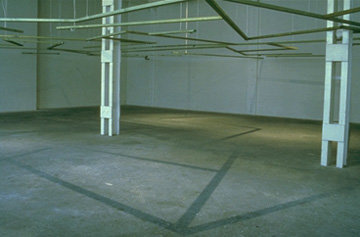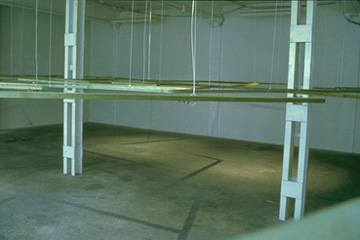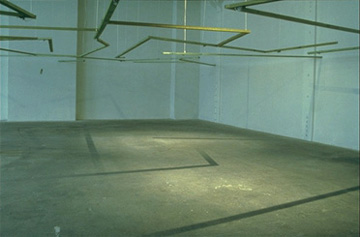

Collaboration with Christoph Rust.
Wood, sensors, audio, Macintosh computer.
Schaffhausen, Switzerland. 1993.


An Interactive Labyrinth
LifeWalk is a Gesamtkunstwerk (“total art work”) that incorporates
sound, sculpture, movement, literary texts, and interactivity. LifeWalk comes
to life only when a visitor enters the installation and goes his/her own way through
the labyrinth, activating sounds along the paths they choose. The inclusion of the
entire room in the artwork creates a “stage.” When visitors enter it, they automatically
become actors. Visitors find their way – or not – into the center of the labyrinth,
experiencing an interaction with the artwork itself. Thus every visitor to LifeWalk
makes their own path, discovering their own version of a “life story.”
Role of Computer Technology in the Installation
The digitized, real-life sounds and voices which become audible at different
locations are controlled and called up from the hard disk by a computer program written
especially for LifeWalk. The computer is linked to sensors which are integrated
into the installation and are activated as the visitor walks through the labyrinth.
Literary Aspects of the Installation
Prior to entering the maze, visitors choose what story they want to hear; in
LifeWalk there are currently three different sets of texts by three authors
(Rust, Rodemer, Hildegard Weeg), two in German and one in English.The meanings of
the sentences visitors hear are often linked by the authors to the various situations
in the labyrinth (entrance, dead end, parting of ways, center) and invite reflective
thinking about various life situations. LifeWalk is, in this respect, a non-linear
literary work that is individually created as the visitor walks through the labyrinth,
sometimes facing decision points where choices must be made, choices which have consequences
for the development of the story.
Schaffhausen, Switzerland
Version I of LifeWalk was realized in May-June 1993 in Schaffhausen, Switzerland.
In this version, pressure-treated wood (green, a color symbolizing life) was used
and hung from the ceiling. The wood hovered at head-height so that a very strong
perspectival foreshortening occurred. A floor-standing version is equally possible.